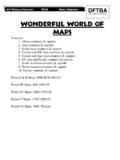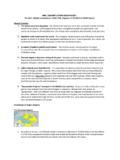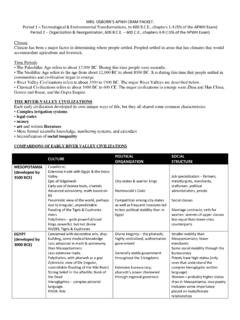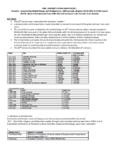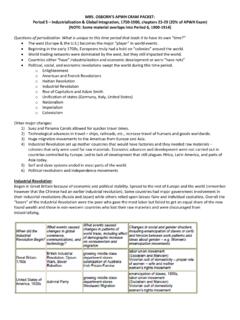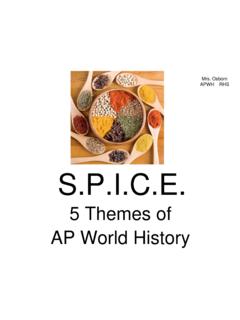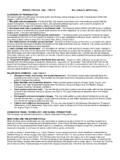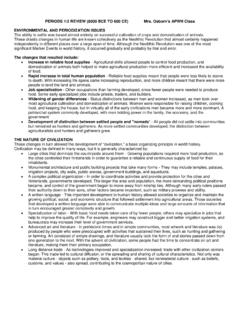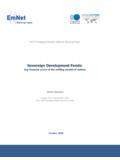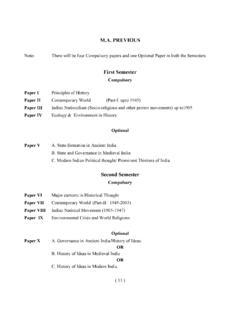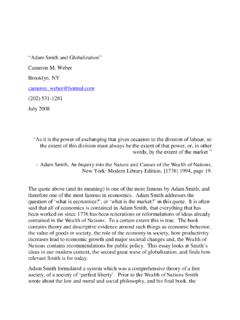Transcription of PERIOD 3 REVIEW: 600 - 1450 C.E. Mrs. Osborn’s …
1 PERIOD 3 review : 600 - 1450 Mrs. Osborn s APWH Class QUESTIONS OF PERIODIZATION Change over time occurs for many reasons, but three phenomena that tend to cause it are: Mass migrations - Whenever a significant number of people leave one area and migrate to another, change occurs for both the land that they left as well as their destination Imperial conquests - If an empire (or later a country) deliberately conquers territory outside its borders, significant changes tend to follow for both the attackers and the attacked. Cross-cultural trade and exchange - Widespread contact among various areas of the world brings not only new goods but new ideas and customs to all areas involved. Some major events and developments that characterized this era were: Older belief systems, such as Christianity, Hinduism, Confucianism, and Buddhism, came to become more important than political organizations in defining many areas of the world.
2 Large religions covered huge areas of land, even though localized smaller religions remained in place. Two nomadic groups - the Bedouins and the Mongols - had a huge impact on the course of history during this era. A new religion - Islam - began in the 7th century and spread rapidly throughout the Middle East, Northern Africa, Europe, and Southeast Asia. Whereas Europe was not a major civilization area before 600 CE, by 1450 it was connected to major trade routes, and some of its kingdoms were beginning to assert world power. Major empires developed in both South America (the Inca) and Mesoamerica (the Maya and Aztec.) China grew to have hegemony over many other areas of Asia and became one of the largest and most prosperous empires of the time. Long distance trade continued to develop along previous routes, but the amount and complexity of trade and contact increased significantly.
3 This unit will investigate these major shifts and continuities by addressing several broad topics: The Islamic World - Islam began in the Arabian Peninsula in the 7th century CE, impacting political and economic structures, and shaping the development of arts, sciences and technology. Interregional networks and contacts - Shifts in and expansion of trade and cultural exchange increase the power of China, connected Europe to other areas, and helped to spread the major religions. The Mongols first disrupted, then promoted, long-distance trade throughout Asia, Africa, and Europe. China's internal and external expansion - During the Tang and Song Dynasties, China experienced an economic revolution and expanded its influence on surrounding areas. This era also saw China taken over by a powerful nomadic group (the Mongols), and then returned to Han Chinese under the Ming Dynasty.
4 Developments in Europe - European kingdoms grew from nomadic tribes that invaded the Roman Empire in the 5th century During this era, feudalism developed, and Christianity divided in two - the Catholic Church in the west and the Eastern Orthodox Church in the east. In both cases, the Church grew to have a great deal of political and economic power. Social, cultural, economic patterns in the Amerindian world - Major civilizations emerged, building on the base of smaller, less powerful groups from the previous era. The Maya, Aztec, and Inca all came to control large amounts of territory and many other native groups. Demographic and environmental changes - Urbanization continued, and major cities emerged in many parts of the world. Nomadic migrations during the era included the Aztecs, Mongols, Turks, Vikings, and Arabs.
5 Long distance trade promoted the spread of disease, including the plague pandemics in the early fourteenth century. THE SPREAD OF ISLAM Religious zeal certainly played an important role in the rapid spread of Islam during the 7th and 8th centuries However, several other factors help to explain the phenomenon: Well-disciplined armies - For the most part the Muslim commanders were able, war tactics were effective, and the armies were efficiently organized. Weakness of the Byzantine and Persian Empires - As the Islamic armies spread north, they were aided by the weakness of the empires they sought to conquer. Both the Byzantine and Persian Empires were weaker than they had been in previous times, and many of their subjects were willing to convert to the new religion. Treatment of conquered peoples - The Qur'an forbid forced conversions, so conquered people were allowed to retain their own religions.
6 Muslims considered Christians and Jews to be superior to polytheistic people, not only because they were monotheistic, but also because they too adhered to a written religious code. As a result, Muslims called Christians and Jews "people of the book." Many conquered people chose to convert to Islam, not only because of its appeal, but because as Muslims they did not have to pay a poll tax. THE SUNNI-SHI'A SPLIT The Arab tribes had fought with one another for centuries before the advent of Islam, and the religion failed to prevent serious splits from occurring in the caliphate. The two main groups were: Sunni - In the interest of peace, most Muslims accepted the Umayyads' rule, believing that the caliph should continue to be selected by the leaders of the Muslim community. This group called themselves the Sunni, meaning "the followers of Muhammad's example.
7 " Shi'a - This group thought that the caliph should be a relative of the Prophet, and so they rejected the Umayyads' authority. "Shi'a" means "the party of Ali," and they sought revenge for Ali's death. Even though the caliphate continued for many years, the split contributed to its decline as a political system. The caliphate combined political and religious authority into one huge empire, but it eventually split into many political parts. The areas that it conquered remained united by religion, but the tendency to fall apart politically has been a major feature of Muslim lands. Many other splits followed, including the formation of the Sufi, who reacted to the luxurious lives of the later caliphs by pursuing a life of poverty and devotion to a spiritual path. They shared many characteristics of other ascetics, such as Buddhist and Christian monks, with their emphasis on meditation and chanting.
8 THE CHANGING STATUS OF WOMEN The patriarchal system characterized most early civilizations, and Arabia was no exception. However, women enjoyed rights not always given in other lands, such as inheriting property, divorcing husbands, and engaging in business ventures (like Muhammad's first wife, Khadijah.) The Qur'an emphasized equality of all people before Allah, and it outlawed female infanticide, and provided that dowries go directly to brides. However, for the most part, Islam reinforced male dominance. The Qur'an and the shari'a recognized descent through the male line, and strictly controlled the social and sexual lives of women to ensure the legitimacy of heirs. The Qur'an allowed men to follow Muhammad's example to take up to four wives, and women could have only one husband. Muslims also adopted the long-standing custom of veiling women.
9 Upper class women in Mesopotamia wore veils as early as the 13th century BCE, and the practice had spread to Persia and the eastern Mediterranean long before Muhammad lived. When Muslims conquered these lands, the custom remained intact, as well as the practice of women venturing outside the house only in the company of servants or chaperones. ARTS, SCIENCES, AND TECHNOLOGIES Because Islam was always a missionary religion, learned officials known as ulama ("people with religious knowledge") and qadis ("judges") helped to bridge cultural differences and spread Islamic values throughout the dar al-Islam, as Islamic lands came to be known. Formal educational institutions were established to help in this mission. By the 10th century CE, higher education schools known as madrasas had appeared, and by the 12th century they were well established.
10 These institutions, often supported by the wealthy, attracted scholars from all over, and so we see a flowering of arts, sciences, and new technologies in Islamic areas in the 12th through 15th centuries. Islamic states in northern India also adapted mathematics from the people they conquered, using their Hindi numerals, which Europeans later called "Arabic numerals." The number system included a symbol for zero, a very important concept for basic calculations and multiplication. Muslims are generally credited with the development of mathematical thought, particularly algebra. Muslims also were interested in Greek philosophy, science, and medical writings. Some were especially involved in reconciling Plato's thoughts with the teachings of Islam. The greatest historian and geographer of the 14th century was Ibn Khaldun, a Moroccan who wrote a comprehensive history of the world.
